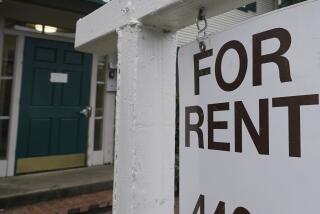Tenants Have Rights Beyond Their Leases
- Share via
In recent years, up to a third of the inquiries received by California’s Consumer Affairs Department involve landlord-tenant problems. About half of these callers have questions about the return of their security and cleaning deposits, says Deputy Director Tom Cecil; the rest involve repairs, discrimination, landlord harassment, rent increases or eviction.
There are places where such matters are left to the lease, but in California and most other states, tenants have certain rights decreed by law. Generally speaking, such law tends to address societal concerns--safety, neighborhood stability, fairness.
The lease handles more individual questions, says Lorelei Echeverri, senior investigator for Los Angeles County’s Consumer Affairs Department, like “who’s going to keep up the lawn, whether animals are allowed and which utilities are the tenant’s responsibility.”
There’s “an enormous difference in law from state to state,” says Ralph Warner, co-author of “Tenants’ Rights,” a handbook for California renters now in its ninth edition. California, considered relatively tenant-oriented, has a roster of landlord-tenant laws. By contrast, says Warner, “we started to do a Texas tenants’ handbook but stopped because it was so thin.”
Where state law is thin, there may be local ordinances in the more populous cities, at least “starting with standards of safety and habitability, and fire codes,” says Charles Fritts, executive vice president of the National Apartment Assn., a property owners’ group in Washington.
Difference in Standards
It might stop there. Indiana, for example, “has habitability and safety laws,” he says, “but no requirement that the security deposit be set aside and few other special protections for the tenant beyond what’s in the lease.”
The concept of “habitability”--the idea that a residential property must be fit for habitation by humans--may be widely accepted as an “implied covenant” between landlord and tenant, but there’s “always some difference in standards,” says Fritts. “Conceivably, someone’s standard of habitability could be four walls and a roof.”
In California, habitability means that the housing conforms with local health and building codes, or with the “affirmative standard characteristics” of “tenantability” listed in the state’s civil code--including approved weather protection, plumbing, water, heating and electricity as well as adequate garbage receptacles and sanitation.
The tenant’s right to a habitable dwelling may be bolstered by protection from “retaliatory eviction” if he complains about the condition of the dwelling.
There may also be a “self-help” or “repair-and-deduct law,” as in California, providing that “if something affects the habitability, and the landlord won’t fix it, the tenant can fix it himself and deduct the cost from the rent,” says Los Angeles real estate lawyer Doug Ring.
Limitations in Law
There could be qualifications, of course, limiting the number of times a tenant can exercise this remedy in a year, or the amount they can spend, and requiring that the landlord have a reasonable chance to make the repair.
California law also invalidates the landlord’s obligation to repair any “dilapidation” or damage that the tenant has caused or contributed to, and assigns the tenants themselves responsibility for proper use and maintenance of the premises.
Tenants may get further help from a widely cited 1974 California Supreme Court case--Green vs. Superior Court--which established a tenant’s right to withhold his rent until the landlord makes necessary repairs.
The tenant, Roger Green, was in fact defending himself against his landlord’s action to evict him and claim back rent. The place was uninhabitable, he said, thanks to rats, roaches, no heat, faulty wiring and plumbing blockages; and he backed his claim with a San Francisco Department of Public Works inspection report citing 80 housing code violations and its order scheduling a condemnation hearing.
In many cases, laws set forth minimum standards, says Fritts, and “a lease can then set terms within those boundaries.”
Landlords, for example, may have right of access to the unit, but be required to give the tenant a minimum of 24 hours notice except in cases of emergency. Security deposits may be required, but could be limited to one or two month’s rent. In California, the limit is two months for unfurnished units and three for furnished.
Not surprisingly, California’s law, for one, reflects the fact that the security deposit is the most frequent subject of complaints, given all the people who claim they didn’t get it back, didn’t get the right amount back or got it back too slowly.
Going on for several pages, the civil code addresses almost all possible questions--whether a lease can call any portion of a security deposit “non-refundable” (it can’t); how much can be required; what happens when the building gets a new owner (new management is responsible for the refund); how soon the landlord must send the full deposit or provide an itemized explanation of any amount deducted (within two weeks), and even how it must be sent (personal delivery or first-class mail).
Unfortunately, there’s no guarantee that all the laws and regulations on landlord-tenant relations, state and local, will be gathered in one text for the layman’s examination.
“Habitability” may be defined by building and safety or health codes, or both; the eviction process may be covered in codes of civil procedure; rent increases will be covered partly in the civil code, partly in rent control ordinances where they exist.
Such matters may also be covered in a lease, but that, of course, is more likely to protect the rights of its author--the landlord.
More to Read
Inside the business of entertainment
The Wide Shot brings you news, analysis and insights on everything from streaming wars to production — and what it all means for the future.
You may occasionally receive promotional content from the Los Angeles Times.










